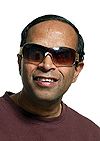Tuesday, February 10th

|
Eyes-Free Interaction: Moving
the User Interface to the Background
TV Raman, PhD
Google Research
|
Abstract: Handheld user interfaces (UIs) should
leverage the growing array of sensors and actuators. With the emergence of
smart phones, the time is fast approaching when devices small enough to fit in
a pocket will be able to meet all of our personal computing and communication
needs. Despite their increased capabilities and functionality, however, the
size and shape of today's computing devices ranging from laptops to handheld
devices are still largely determined by the same factors they were a decade ago
- namely, the keyboard and visual display. But as user interfaces move into the
background, this can begin to change.
Next-generation user interfaces are extending beyond the
traditional visual interface to leverage hearing and touch, thereby augmenting
overall user interaction. In addition, as computing devices have become a more
integral part of our daily lives, they've acquired a rich diversity of I/O
peripherals capable of collecting and presenting useful information about the
physical environment.
A successful UI, like a well-designed doorknob, is one
that no one notices. As handhelds incorporate more ubiquitous computing
technologies, we can expect the UI to recede further into the
background.
Biosketch: TV Raman is a computer scientist who
was born and raised in Pune, India. His accessibility research interests are
primarily auditory user interfaces and structured electronic documents. He has
worked on speech interaction and markup technologies in the context of the
World Wide Web at Digital's Cambridge Research Lab (CRL), Adobe Systems, IBM
Research, and is currently a research scientist at Google Research. He holds
nine patents and earned a PhD in applied mathematics at Cornell
University.
- Contact information:
- Google Research
- Mountain View, CA
- raman - at- google.com
- Lecture Material:
- Slides - 475 Kb pdf
file
- Audio - 56:47 - 13.0 Mb mp3
file
- Links:
- TV Raman on the
Internet
- Speech
Enabled Eyes-Free Android Applications
- Thinking
of Mathematics - An Essay On Eyes-free Computing
|
